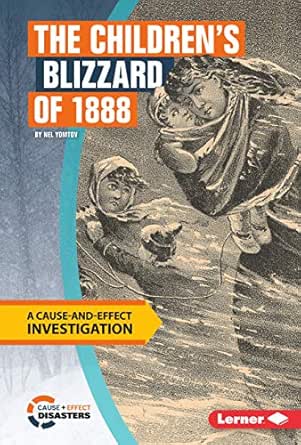- Children's Blizzard Of 1888 Nebraska
- Children's Blizzard Of 1888 Resourcesteam Patton War
- Children's Blizzard Of 1888 Resourcesteam Patton Silver Dollar
- Children's Blizzard Of 1888 Resourcesteam Patton Oswalt
- Children's Blizzard Of 1888 Resourcesteam Patton Street
“Nom de Guerre” is a French expression which, translated literally, means “war name”. Think “Maverick”, “Ice Man” and “Goose” in Top Gun. From a more historical perspective, think of General Thomas J. Jackson. Almost everyone calls him only by his nom de guerre: “Stonewall Jackson”. Many of our better-known military leaders have had a nom de guerre. In fact, some have had several, which reflect the relative success (at least as perceived by the public) of their military careers at the time the name is conferred.
RG1639.AM: Jessie Eva (Starr) Patton Cravin, 1880-1961 - This collection consists of the nine page typescript reminiscences of Jessie Starr regarding 'The Big Blizzard,' of January 12, 1888. As children, Jessie Starr and her siblings were lost in the storm for several hours. The Starr family lived in the Valentine, Nebraska area. 1888 – The Great Blizzard of 1888 begins along the eastern seaboard of the United States, shutting down commerce and killing more than 400. 1916 – USS Nevada (BB-36) is commissioned as the first US Navy 'super-dreadnought'. 1927 – In New York City, Samuel Roxy Rothafel opens the Roxy Theatre.

Take for instance General Robert E. Lee. At the end of the Civil War, Lee was so venerated in the South (and pretty much in the North, too) that a small boy, learning about Lee in his classroom, asked his mother, “Momma, I’m confused. Was General Lee in the Old Testament or the New?” [1] But Lee was not always so lofty a figure in the public’s eye. At the start of the war, Lee was in charge of the disappointing Cheat Mountain Campaign in western Virginia. He was viewed by the public as being too cautious in battle, and was dubbed “Granny Lee”. After this campaign, Confederate President Jefferson Davis reassigned Lee (who had a background with the Corps of Engineers) to supervise the build-up of coastal defenses in South Carolina. This, and the construction of defensive trenches around Richmond earned Lee the sobriquet “King of Spades”, and it was not conferred in a positive tone. These early names gave way later to more positive nicknames later, after Lee’s brilliance as a field commander was established. Later we see him referred to affectionately as “Bobby Lee” and reverently as “Marse Robert” (marse is slang for master).
Ulysses S. Grant
And how about Lee’s nemesis, General Ulysses S. Grant? After the successful investment of Fort Donelson, Grant received a request for surrender terms from the rebel commander, Simon Bolivar Buckner. Grant’s famous reply was “No terms except unconditional and immediate surrender can be accepted.” [3] The capture of Fort Donelson in 1862 was one of the earliest Union successes in the Civil War, when the North was hungry for good news. The press seized upon the term “unconditional surrender”, and since it fit neatly into Grant’s initials, U.S. Grant became “Unconditional Surrender Grant”. Later, during the long and bloody campaign against Lee in 1864, when the war seemed interminable and Northern morale was flagging, Grant was nicknamed “The Butcher” or “Grant the Butcher” due to the high number of Union casualties, especially at Cold Harbor. This was not any more descriptive of Grant than “Granny Lee” was descriptive of Lee, since Grant had shown time and again during the war his care of the troops under his command. When Grant was finally able to pin Lee down and force a surrender he offered generous terms, according to Abraham Lincoln’s wishes to “let ’em up easy” and his own inclinations. After the surrender he was the “Hero of Appomattox” and once again the darling of the North.
In World War II, General George S. Patton was known as “Old Blood and Guts” because he was the most aggressive fighting general in the European Theater. Check out his speech to his troops upon assuming command of the Third Army just before D-Day, and you’ll get a little insight to his approach to war. In North Africa, he squared off against a wily opponent in Germany’s Erwin Rommel, respectfully calledChildren's Blizzard Of 1888 Nebraska
“The Desert Fox” by the British. Which reminds me of the unstated rule of noms de guerre . A regular pseudonym may be self-imposed, say for example “Mark Twain”, which Samuel Langhorne Clemens chose to commemorate his days as a Mississippi riverboat pilot (“mark, twain” was the boatman’s call at measuring two fathoms, a minimum safe depth for navigation). Not so a nom de guerre, which must be chosen by your friends, the soldiers under your command, the press, or perhaps by your enemy.
. A regular pseudonym may be self-imposed, say for example “Mark Twain”, which Samuel Langhorne Clemens chose to commemorate his days as a Mississippi riverboat pilot (“mark, twain” was the boatman’s call at measuring two fathoms, a minimum safe depth for navigation). Not so a nom de guerre, which must be chosen by your friends, the soldiers under your command, the press, or perhaps by your enemy. Sources:
[1] The History Channel Presents The Civil War, The History Channel DVD Collection
[2] Lee’s Nicknames, Son of the South
[3] Correspondence Between Ulysses S. Grant and Simon B. Buckner Discussing Surrender Terms at Ft. Donelson, CivilWarHome.com
[4] The Famous Patton Speech, by Charles M. Province
Children's Blizzard Of 1888 Resourcesteam Patton War
In this week’s installment of our recurring series bringing you the history of Princeton University and its faculty, students, and alumni, the Princetonian urges an alumni organization to hire editors with more “integrity”, a new program in electrical engineering is announced, and more.
March 25, 1965—Detectives find no explanation for the apparent suicide of lecturer Robert M. Hurt, 29, described by colleagues as “relaxed” and “cheerful” prior to his death.
Robert Hurt, ca. 1960s. Historical Photograph Collection, Faculty Photographs Series (AC059), Box FAC51.
March 26, 1986—After Laura Ingraham resigns as editor of the Concerned Alumni of Princeton’s Prospect magazine, the Daily Princetonian urges CAP chair David Condit ’73 to be “looking for integrity” next time, noting that the journalistic “indiscretions which have appeared in Prospect are legion” under the editorial direction of both Ingraham and her predecessor, Dinesh D’Souza. There will be no next time, however, the sole issue of Prospect Ingraham has put out will be the last ever published by CAP.
This was the last issue of the Concerned Alumni of Princeton’s magazine, Prospect, and the only one with Laura Ingraham in her year as the editor, although the official publication schedule was every other month. In this issue, Ingraham, a recent graduate of Dartmouth, wrote an extended article on why feminism was, in her opinion, destructive to Princeton and a shorter editorial claiming that Princeton’s conservative students had no mentors because conservative faculty were being silenced. The cover art references another article arguing against Princeton University divesting from apartheid South Africa, though many students had pressured the institution to divest for decades. Princeton University Publications Collection (AC364), Box 16.
Children's Blizzard Of 1888 Resourcesteam Patton Silver Dollar
March 29, 1889—At the annual dinner of the Princeton Alumni of New York and Vicinity, Princeton president Francis Landey Patton announces a new program in electrical engineering.
Children's Blizzard Of 1888 Resourcesteam Patton Oswalt
The first electrical engineering laboratory at Princeton, 1890. Historical Subject Files (AC109), Box 31, Folder 4.
March 30, 1978—About 70 students join Princeton University Library Assistants union members at a rally that attracts 140 people as PULA contract negotiations stall. It is believed to be the first time Princeton’s students have joined in public support of union employees in a labor dispute with the institution.
For the previous installment in this series, click here.

Children's Blizzard Of 1888 Resourcesteam Patton Street
Fact check: We always strive for accuracy, but if you believe you see an error, please contact us.

